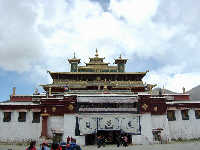| |
Samye Monastery
( 2005-10-27 )
 Located in Laying, the Samye Monastery was the first monastery built in Southwest China's Tibet Autonomous Region. It was likely founded in 767 under the patronage of King Trisong Detsen, and under the direction of Indian masters Padmasambhava and Shantarakshita. Construction was completed in 779. Located in Laying, the Samye Monastery was the first monastery built in Southwest China's Tibet Autonomous Region. It was likely founded in 767 under the patronage of King Trisong Detsen, and under the direction of Indian masters Padmasambhava and Shantarakshita. Construction was completed in 779.
AlthoughBuddhismhad been transmitted into Tibet at that time, there was no formal Buddhist priest or Buddhist rituals. Tubo King Trisong Detsen decided to invite Santarakshita and Padmasambhava, both Buddhist experts in India, to promote Buddhism in Tibet.
Samye means "unimaginable" in Tibetan. It was said that when Tritsong Detsen asked for advice about the monastery's construction, Padmasambhava, exerting his magic power, showed the king an image of a monastery in his palm; this led to the name of Sanye.
Padmasambhava chose the construction site, while Santarakshita designed the monastery. After the construction was completed, Buddhism became the official religion in Tibet. Learned monks from inland China and India were invited to Tibet to translate Buddhist sutras into Tibetan. Trisong Detsen selected seven nobles to be the first monks in Tibet. Thus Samye became the first formal monastery that established the triratna -- the three components of the Buddha, the dharma (teaching), and the Sangha (Buddhist priesthood).
The Samye Monastery has experienced a dozen centuries since its completion. It was once ruined in the late Tubo period when Buddhism was banned. In the early 10th century, the Sagya Prince of Dharma rebuilt the monastery.
The monastery combined styles of Chinese, Tibetan, and Indian. The layout was designed completely according to an ideal universe in Buddhist scriptures. Utse, the Great Hall symbolizing Sumeru in a perfect Buddhist universe, is the largest structure in the monastery, and is circled by the sun and moon chapels. Four stupas of different styles, colored in red, white, black, and green to represent four Heavenly Kings, stands at four corners of the hall. Four larger halls and eight smaller ones, evenly distributed around Utse, are deemed as the 12 continents in that universe. The monastery is secluded from the outside world by a circular wall, with thousands of Buddha statues sitting on it, which represents a mountain near the border of the universe.
|
|

